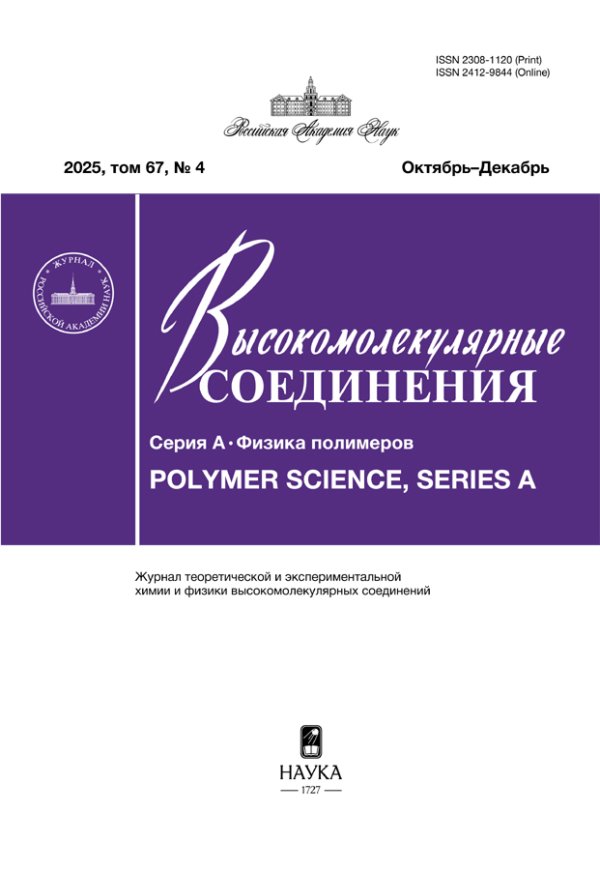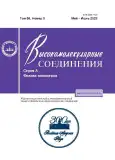Том 65, № 3 (2023)
ПОЛИЭЛЕКТРОЛИТЫ
Термо- и pH-чувствительное поведение сополимеров N-винилкапролактама и N-винилимидазола
Аннотация
Свободнорадикальной сополимеризацией в массе синтезированы сополимеры N-винилкапролактама и N-винилимидазола (40–60 мол. %). Методами динамического и статического рассеяния света и высокочувствительной дифференциальной сканирующей калориметрии исследовано термочувствительное поведение водных растворов сополимеров в широкой области pH. При изменении pH среды от щелочного до кислого обнаружены три области термоиндуцированного конформационного поведения: I – область фазового расслоения, II – область конформационного перехода в состояние мезоглобул, III – область стабильного молекулярного раствора полиэлектролита. Для растворов сополимеров в отсутствие добавленной соли выявлены значительные полиэлектролитные эффекты, проявляющиеся в наличии быстрой и медленной диффузионных мод на распределениях по временам релаксации. Умеренное повышение ионной силы при добавлении низкомолекулярной соли приводит к экранированию полиэлектролитных эффектов, но не меняет принципиально набор областей конформационного поведения при разных pH. Существование различных типов термоиндуцированного конформационного поведения в разных областях pH объясняется изменением баланса между гидрофобными взаимодействиями звеньев N-винилкапролактама и электростатическими взаимодействиями слабоосновных звеньев N-винилимидазола.
 163-174
163-174


СТРУКТУРА И СВОЙСТВА
ПОЛУЧЕНИЕ НЕТКАНЫХ УГЛЕРОДНЫХ МАТЕРИАЛОВ ИЗ ПОЛОТЕН НА ОСНОВЕ ЛЬНЯНОЙ ЦЕЛЛЮЛОЗЫ И ВИСКОЗНЫХ ВОЛОКОН
Аннотация
Предложен способ получения нетканых углеродных материалов путем постадийной термической обработки целлюлозного войлока. В качестве нетканых прекурсоров использовали полотна, сформированные иглопробивным методом из волокнистой льняной целлюлозы и вискозных волокон. Выбраны оптимальные соотношения компонентов для получения прекурсоров углеродных полотен на основе результатов по формированию нетканых полотен и термического анализа для различных смесевых составов. Показано, что содержание льняных волокон в системе должно быть не менее 50%. Вискозные волокна играют роль армирующего материала и на данный момент не могут быть полностью исключены из системы. С увеличением содержания льняной целлюлозы величина углеродного остатка возрастает. Механические свойства углеродного войлока обеспечиваются физической сеткой фрикционных и дисперсионных контактов между индивидуальными волокнами. При температурной обработке композиционного нетканого материала морфологические особенности прекурсорных волокон сохраняются. С помощью рентгеноструктурного анализа и просвечивающей электронной микроскопии определены межплоскостные расстояния углеродных слоев в углеродном материале. Доля углерода при температурной обработке до 1700°С составляет не менее 90%, после графитации до 2400°С чистота продукта превышает 99%. Максимальные значения углеродного остатка при этой температуре могут достигать 25–27%. Измерены коэффициенты теплопроводности углеродного войлока, полученные значения на 30% меньше по сравнению с показателями для углеродных тканей.
 175-185
175-185


МЕДИЦИНСКИЕ ПОЛИМЕРЫ
ФИЗИКО-ХИМИЧЕСКИЕ, СОРБЦИОННЫЕ И МОРФОЛОГИЧЕСКИЕ ХАРАКТЕРИСТИКИ ФИБРОИНА КОКОНОВ ШЕЛКОПРЯДА BOMBYX MORI И ПОЛИФУНКЦИОНАЛЬНЫЙ ГЕМОСОРБЕНТ НА ЕГО ОСНОВЕ
Аннотация
На основе фиброина, выделенного из коконов шелкопряда Bombyx mori, получены полифункциональные гемосорбенты для детоксикации крови и сыворотки крови. Проведены их физико-химические и морфологические исследования, изучены сорбционные свойства. Показано, что полученные гемосорбенты имеют высокую сорбционную активность. По сорбционной активности гемосорбент на основе фиброина, обработанного ультразвуком и сверхвысокочастотным облучением, превосходит серийно выпускаемый “Научно-производственным предприятием Биотех-М” гемосорбент ВНИИТУ-1 в колонке для гемосорбции “Гемос®-КС”.
 186-193
186-193


ЭЛЕКТРОПРОВОДЯЩИЕ МАТЕРИАЛЫ НА ОСНОВЕ ПОЛИЛАКТИДА И ПОЛИПИРРОЛА ДЛЯ БИОМЕДИЦИНСКИХ ПРИМЕНЕНИЙ
Аннотация
Электропроводящие матрицы для тканевой инженерии разной формы получены на основе двух биосовместимых полимеров: полилактида и полипиррола. Основой композиционных матриц являются пористые, проницаемые пленки или трубки из полилактида, полученные методом электроформования. На развитую поверхность матриц, состоящих из хаотически переплетенных волокон микронной толщины, нанесен слой электропроводящего полипиррола. Исследована структура тканевых инженерных матриц, их механические, окислительно-восстановительные и электропроводящие свойства. Установлено, что тканевые матрицы стабильны в процессах электростимуляции при долговременной подаче циклических потенциалов.
 194-204
194-204


СМЕСИ ПОЛИМЕРОВ
СТРУКТУРА И СВОЙСТВА НАНОКОМПОЗИТОВ ПОЛИПРОПИЛЕНА С ПОЛИВИНИЛОВЫМ СПИРТОМ, ПОЛУЧЕННЫХ МЕТОДОМ КРЕЙЗИНГА
Аннотация
На основе пленок ПП, деформируемых в растворах ПВС по механизму крейзинга, получены новые полимер-полимерные нанокомпозиты. Методами АСМ, ДСК, гравиметрии, механических испытаний, измерения краевых углов смачивания и объемной пористости исследованы механизм деформации ПП в растворах ПВС, структура, состав, теплофизические свойства и смачиваемость композитов. Cтепень растяжения ПП и концентрация ПВС в растворе позволяют контролировать состав нанокомпозитов. Содержание ПВС может достигать 45 мас. % при степени вытяжки ПП 300%. После удаления летучей жидкой среды ПВС кристаллизуется в затрудненном пространстве мезопористой матрицы ПП с понижением степени кристалличности до 12‒14%. Введение гидрофильного компонента приводит к улучшению смачивания ПП, и краевой угол снижается с 98° для исходного ПП до 42° для композита. Гидрофилизацию с использованием явления крейзинга можно рассматривать как способ модификации, переработки и вторичного использования крупнотоннажного полимера.
 205-211
205-211


СТРУКТУРНО-МОРФОЛОГИЧЕСКИЕ И РЕОЛОГИЧЕСКИЕ ОСОБЕННОСТИ СОВМЕСТНЫХ РАСТВОРОВ ЦЕЛЛЮЛОЗЫ И СОПОЛИМЕРА ПАН В N-МЕТИЛМОРФОЛИН-N-ОКСИДЕ
Аннотация
Получены 18%-ные смесевые растворы целлюлозы и тройного сополимера ПАН, содержащего метилакрилатный и метилсульфонатный сомономеры, в N-метилморфолин-N-оксиде во всем диапазоне составов. Все полученные системы на основе целлюлозы и ПАН двухфазны, причем морфологические особенности эмульсий изменяются в зависимости от фазового состава и интенсивности деформационного воздействия от высокодисперсной изотропной до фибриллярной. При высоких напряжениях сдвига, реализуемых при получении растворов в экструдере, все эмульсии характеризуются однотипной микрогетерогенной морфологией, которая при деформировании трансформируется в фибриллярную. ИК-спектроскопическими исследованиями установлено, что в процессе получения между функциональными группами макромолекул сокомпонентов протекают специфические взаимодействия, приводящие к формированию ассоциатов ПАН/целлюлоза, претерпевающих гидрофобное отталкивание по границам раздела. Именно этот процесс инициирует фибрилляцию фазы целлюлозного раствора в присутствии раствора ПАН при деформировании. Характер реологического поведения смесевых растворов во всем интервале концентраций в непрерывном и динамическом режимах при температурах 110–130°С является прямым следствием фазового состава и морфологических превращений, протекающих в процессе деформирования. Выбраны составы эмульсий, характеризуемые вязкоупругими свойствами, позволяющими успешно формовать композитные волокна.
 212-224
212-224


КОМПОЗИЦИОННЫЕ ПЛЕНКИ НА ОСНОВЕ СМЕСЕЙ МЕТИЛЦЕЛЛЮЛОЗЫ С ПОЛИУРЕТАНИМИДОМ, ПОЛУЧЕННЫЕ ИЗ ИХ РАСТВОРОВ В ДИМЕТИЛАЦЕТАМИДЕ
Аннотация
Получены композиционные пленки метилцеллюлозы с полиуретанимидом. При содержании в пленках полиуретанимида больше 50% наблюдается фазовое разделение полимеров. Методами динамического механического анализа и рентгеноструктурного анализа изучены структурная организация пленок и определены температуры релаксационных переходов, а также исследованы механические характеристики композиционных пленок.
 225-229
225-229


КОМПОЗИТЫ
ВЛИЯНИЕ СВЕРХНИЗКОГО СОДЕРЖАНИЯ ГРАФЕНА НА ИЗНОСОСТОЙКИЕ СВОЙСТВА КОМПОЗИТОВ НА ОСНОВЕ СВЕРХВЫСОКОМОЛЕКУЛЯРНОГО ПОЛИЭТИЛЕНА
Аннотация
Методом полимеризации in situ получены композиты с содержанием графенового наполнителя в образцах от 0.014 до 0.05 мас. %. Исследовано влияние сверхнизкого содержания графена на комплекс износостойких и трибологических характеристик синтезированных композитов на основе сверхвысокомолекулярного полиэтилена. Проведено исследование износостойкости синтезированных материалов при высокоскоростном воздействии водно-песчаной суспензии, износа в режиме микрорезания, фрикционной износостойкости. Также найдены значения коэффициента трения по стали. Введение графена в матрицу сверхвысокомолекулярного ПЭ приводит к увеличению стойкости к абразивному износу в режиме микрорезания, а также к увеличению стойкости к износу при воздействии водно-песчаной суспензии (износ по свободному абразиву).
 230-236
230-236















